#funerary artifacts
Explore tagged Tumblr posts
Text
Life-Sized Mortuary Doll from Siberia, c.250 CE: a small pouch filled with cremated human remains was tucked into the body of this mannequin, which was then stuffed with grass, dressed in furs, and buried

The mannequin measures about 1.5 meters (nearly 5 feet) tall, and it was crafted out of leather, fur, woollen fabric, tendon thread, silk, and grass. This is one of several mortuary dolls that have been found at the burial complex known as Oglakhty cemetery, which is located in the Oglakhty mountains of southern Siberia.
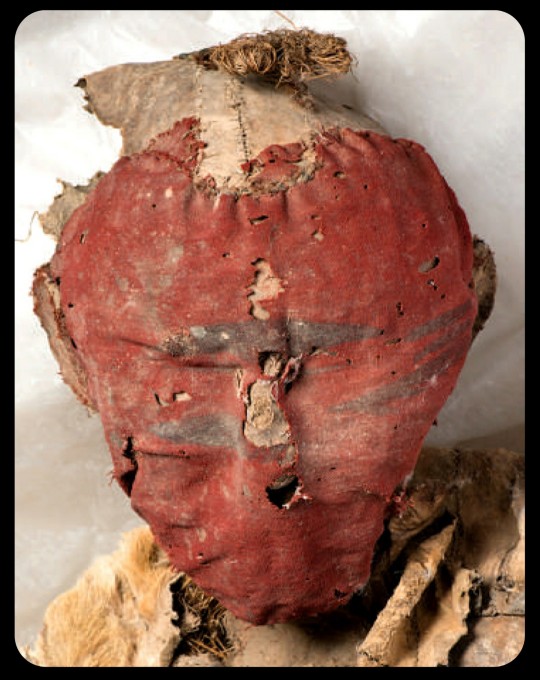
The mannequin's face was created from a patch of red woollen fabric; a rolled-up piece of leather was tucked beneath that patch in order to create the shape of the nose, while leather flaps were used to form the ears. Several black lines were also drawn across the face using charcoal.

The mannequin was positioned with its head resting atop a leather cushion filled with grass and reindeer fur.

Oglakhty cemetery is associated with the Tashtyk culture of southern Siberia. This article describes their unique burial practices, which often included a mix of mummification and cremation rituals:
The communities belonging to this group left numerous burial sites with an expressive funeral rite famous for its tradition of funeral masks and ‘dummies’: leather-made models of human bodies up to 1.5m in length, stuffed with grass, and containing charred human bones.
Of special interest is the fact that different rites were used to bury individuals in the same grave: the mummies and dummies both contained human bones. Remains of the mummies, i.e. dry bodies with trepanned skulls and faces covered with gypsum masks were lying side by side with the dummies.
And as this article notes:
These mannequins or so-called ‘dolls’ are the only surviving examples of burials of this type.
It's believed that the mannequins are dressed in clothing that was originally worn by the dead people they represent. Some of the mannequins also have plaits of human hair that were likely taken from the dead just prior to cremation; the hair was then used to form neatly-braided hairpieces that were typically placed upon the mannequins' heads.
Many of the graves at Oglakhty cemetery exhibit a peculiar mix of both inhumation and cremation. That blend of rituals is often attributed to the arrival of peoples/traditions from other regions, and the cultural diffusion that gradually occurred as a result:
Different ways of burying people in the same graves in the early Tashtyk cemeteries may reflect their different origins: descendants of local population and immigrants living and buried alongside each other.
Sources & More Info:
Antiquity: Pastoralists and Mobility in the Oglakhty Cemetery of Southern Siberia
Masters of the Steppe: Mummies and Mannequins from the Oglakhty Cemetery in Southern Siberia
Quarternary International: New Results of Radiocarbon Dating from the Oglakhty Cemetery
Research Square: First Ancient DNA Analysis of Mummies from the Post-Scythian Oglakhty Cemetery
Archeotravelers: The Face Hidden Behind the Mask
Great Sites of the Ancient World: Siberia's Oglakhty Mountains
#archaeology#artifacts#history#anthropology#oglakhty#mortuary dolls#mannequins#cremation#mummification#burial practices#siberia#russia#funerary rites#rituals#tashtyk#scythians#cultural diffusion#mummies and dummies
94 notes
·
View notes
Text
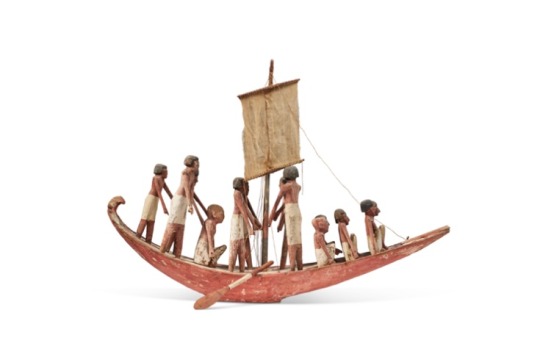
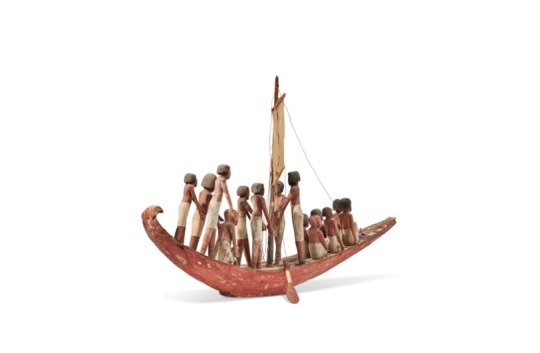

AN EGYPTIAN GESSO-PAINTED WOOD FUNERARY MODEL OF A BOAT MIDDLE KINGDOM, 11TH-12TH DYNASTY, 2087-1759 B.C.
#AN EGYPTIAN GESSO-PAINTED WOOD FUNERARY MODEL OF A BOAT#MIDDLE KINGDOM#11TH-12TH DYNASTY#2087-1759 B.C.#ancient artifacts#archeology#archeolgst#history#history news#ancient history#ancient culture#ancient civilizations#ancient egypt#egyptian history#egyptian mythology#egyptian art
425 notes
·
View notes
Text

Meet Miss Carthage!
An ancient North African city-state turned maritime empire and the dominant power of the western Mediterranean prior to Rome's ascension. Carthage is most well-known for its participation in the Punic Wars against the Roman Republic, war elephants and the military general Hannibal Barca.
#hetalia#hetalia oc#hws carthage#ancientalia#my art#I referenced so many historical artifacts for this#carthaginian funerary masks are so metal
43 notes
·
View notes
Text
Golden Larnax

The Golden Larnax from the royal tomb of Philip II at Vergina, Macedonia, is one of the most iconic and significant discoveries of ancient Greek archaeology.
Unearthed in 1977 in the Tomb of Philip II, the father of Alexander the Great, the larnax is a lavishly crafted funerary chest made of gold, showcasing the wealth and artistry of the Macedonian royal family.
This remarkable artifact is believed to have contained the remains of Philip II, although it is likely that the larnax itself was part of a larger burial complex, emphasizing the high status of the king within his tomb.
The larnax is a true masterpiece of Hellenistic goldsmithing, with intricate designs that reflect the wealth and sophistication of the Macedonian monarchy during the 4th century BCE.
Its surface is adorned with delicate reliefs, including motifs of geometric patterns and symbolic imagery, which were intended to honor the deceased and protect the tomb.
The use of gold as a material further underscores the significance of the tomb, as it was a metal associated with the divine and the eternal in ancient Greek culture.
The discovery of the Golden Larnax was a pivotal moment in the study of ancient Macedonia and the reign of Philip II.
The tomb at Vergina, which also yielded other priceless artifacts such as weapons, jewelry, and frescoes, provides invaluable insights into the funerary practices of the time.
Today, the Golden Larnax remains a symbol of Macedonia's royal splendor and the legacy of one of history's greatest military leaders.
It is now housed in the Museum of the Royal Tombs at Vergina, where it continues to attract visitors and scholars from around the world.
#Golden Larnax#Philip II#royal tomb#ancient Greek archaeology#ancient greece#archaeology#Tomb of Philip II#Alexander the Great#larnax#funerary chest#Macedonian royal family#artifact#ancient Macedonia#Museum of the Royal Tombs#Vergina#Macedonia#ancient history
24 notes
·
View notes
Text
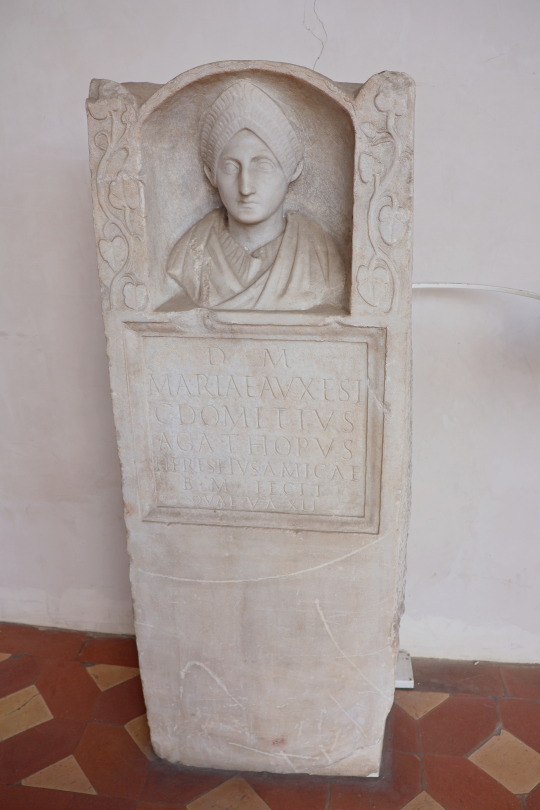
Ancient Roman funerary relief dedicated to Maria Auxesis, by her friend. She died at 41.
Early 2nd century CE.
Found in Rome, currently in the Terme di Diocleziano.
Feb. 2024
#funerary art#sculpture#baths of diocletian#terme di diocleziano#tomb#original photography#photography#taphophile#taphophilia#lensblr#photographers on tumblr#tombstone#museum#artifact#italy#italia#rome#roma#ancient rome#ancient roman#archaeology#ancient art#ancient history#antiquities#wanderingjana
19 notes
·
View notes
Text
in the locked tomb universe, communing with the spirits of the dead is entirely possible, so at what point does calling up the fifth house specialists to commune with the spirits of the dead pass from “calling up grandma to ask about her totally secret fourth marriage to win a family argument” to “primary source archeology”?
and if doing that is a perfectly reasonable thing that is possible, do the houses refuse to fully dispose of bodies until all the heirs have also passed away? what about historically significant figures from hundreds of years ago? are houses constantly having sixth house archival weirdos show up asking for their skeletons? or do the houses keep relics for family or historical purposes and dump the rest? if so where are they kept? ten thousand years of history, when do mausoleums start getting relabeled as long term storage? or is this something that jod had to actively suppress because bad habits set bad precedents?
#I have zero interest in funerary practices as an artifact of human culture#EXCEPT for the fact that my mom (not naturally a morbid person) is still keeping her own mother's ashes in a shoebox in her closest#the same person who did in fact have a secret fourth marriage that my mom dug up from records#the locked tomb
9 notes
·
View notes
Text

Funerary Altar Inscribed to Mystes and Her Son Dorius
1st century C.E
White marble
Roman
------------------------------------------
Located at The Toledo Museum of Art
6 notes
·
View notes
Text

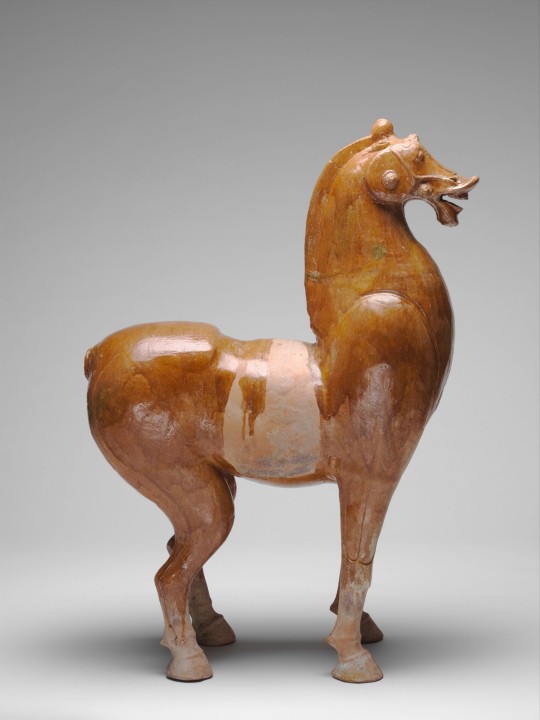


Earthenware horse with Roman-style bridle ornaments, China, 25-220 CE, Eastern han period, Han dynasty
"Valued for their strength and endurance, horses symbolized wealth and power in ancient China; in a funerary context, they were believed to transport souls to the next world. Made specifically for burial in a tomb, this sculpture is exceptionally important for several reasons: its large size, brilliant glaze, near-perfect condition, and Romanstyle bridle ornaments. The bridle sports five circular medallions, each with a human face. Their number, placement, and decoration accord exactly with Roman convention and thus provide evidence of early Western influence in China. Horses were especially prized by rulers of the Han dynasty for their military value, as cavalry warfare was used to fend off frequent attacks of nomadic invaders. In the second century BCE, campaigns to procure Central Asian horses led to both the expansion of the Han Empire’s borders and to increased contact between China and the nations to its west along the Silk Road."
harvard art museums
#my little pony...#archaeology#artifact#history#antique#horse#china#chinese art#han dynasty#earthenware#sculpture#funerary#asia#beastie
1 note
·
View note
Text
Greek funerary diadem

ITEM Funerary diadem MATERIAL Gold CULTURE Greek PERIOD 4th - 3rd Century B.C DIMENSIONS 250 mm x 22 mm, 3,9 gr CONDITION Good condition PROVENANCE Ex French private collection, acquired before 1990s BIBLIOGRAPHY The Metropolitan Museum of Art, Accession number 74.51.3535. The British Museum Collection Online, Accession number 1877,0910.60, 1877,0910.58 and 1877,0910.77. In ancient Greek culture, the use of gold funerary diadems was a prominent practice, particularly during the Classical and Hellenistic periods. These diadems were elaborate headpieces made of gold and were often crafted with intricate designs and symbolic elements. They held a significant role in funerary customs, symbolizing the deceased's elevated status, wealth, and connection to the divine. Gold, as a precious metal, was associated with the gods in Greek mythology, and its use in funerary diadems reflected the belief in an afterlife where the deceased would continue to enjoy divine favor. The designs of these diadems were diverse, featuring motifs such as floral patterns, mythological scenes, and symbols associated with immortality. The intricate craftsmanship demonstrated the artistic skills of ancient Greek goldsmiths, who employed techniques such as repoussé and filigree to create these exquisite pieces. Read the full article
#ancient#ancientart#ancienthistory#artefact#artifact#ancientartifacts#antiquities#antiquity#art#artobject#ancientworld#history#classical#archaeology#greek#greece#ancientgreece#gold#funerary#diadem#ancientjewelry#jewel#jewelry
0 notes
Text
1,200-year-old lord's tomb laden with gold unearthed in Panama

Archaeologists in Panama have discovered a 1,200-year-old tomb belonging to pre-Hispanic royalty that also contains a sizable gold collection.
The tomb is located in El Caño, an archaeological park in the Coclé province of central Panama. It is the final resting place of an "important Coclé lord," according to a translated statement from Panama's Ministry of Culture.
The lord likely lived during the late 700s and would have been in his 30s when he died, according to an El Caño Foundation Facebook post.
The tomb contained an impressive amount of grave goods belonging to the unnamed royal, such as ceramic artifacts and gold pieces from a funerary trousseau — a collection of an individual's personal possessions. Read more.
445 notes
·
View notes
Text
[ HoS ] ANCIENT EGYPTIAN AMULETS

The Isis knot is just as iconic as it is mysterious. It is unclear what this knot is meant to represent exactly: some Egyptologists argue it may have been a very ancient form of menstrual pad, while others believe it had religious or decorative purposes."

The Djed Pillar, representing Osiris' spine, is a powerful amulet used by both the living and the dead. Often made from various materials, it is also depicted in Egyptian art with a pair of hands and a feathered crown topped by the sun, symbolizing Osiris and divine resurrection.

The Ancient Egyptians believed the core of our intelligence and mind was the heart, rather than the brain. They couldn’t determine this latter's purpose, so during the mummification process, they discarded it, pulling it out through the nose with a hook, leaving only the essential vital organs to be preserved for the afterlife. In fact, the heart was regarded as both the source of emotions and feelings, and the seat of one's entire being—no wonder it was shaped like a vase!

Even those unfamiliar with Ancient Egyptian art recognize this iconic symbol. Over time, the Ankh, or 'Key of Life,' became synonymous with Egypt itself and its ancient religion. Some Egyptologists suggest that its shape may have been inspired by a knotted cloth, though its use was primarily decorative.
In some murals, strings of Ankh symbols were used to represent water, as it was the ultimate symbol of life for the Egyptians—everything originated from it, making the Ankh a fitting metaphor.
In other depictions, gods are shown 'spoon-feeding' pharaohs and the dead with an Ankh in their hands, symbolizing the soul being revived by the divine as it begins its journey to the afterlife."

One of the most common artifacts found by archaeologists during excavations, the Scarab is an iconic amulet that served many purposes for both the living and the dead.
In life, it was used as a seal, a protective amulet, or simply as jewelry, often worn as a ring or necklace, typically linked to a golden wire. In death, it was frequently placed around the neck and functioned as a protective charm for the heart, earning the name 'heart scarab.'
The scarab was the sacred animal of the god Khepri and symbolized the sun.

For the Ancient Egyptians, the soul was divided into several parts—nine in total, including the physical body. It was crucial that each of these parts made it to the afterlife, allowing the dead to be reborn in the Duat, the Egyptian underworld. The Ba, which represents our unique personality, was often placed on the mummy's chest so it could rest near the heart, another key component of the soul.

In Ancient Egypt, the papyrus stem was a common decorative element. Temple columns were often shaped to resemble this iconic plant. Its frequent appearance in Egyptian art was partly due to its significant color: green, the color of resurrection, sacred to the god Osiris. By placing a papyrus-shaped amulet around a mummy’s neck, the Egyptians believed it would ensure eternal youth for the soul in the afterlife.

The Eye of Horus, modeled after the left eye of the falcon god of kingship, is one of the most iconic symbols of Ancient Egypt. Found in numerous tombs, it was continuously produced from the late Old Kingdom through to the Roman period. It served both as an amulet to ward off evil and as a decoration on boats and mummies. Representing the moon and the righteous nature of the god, it is also closely connected to other benevolent deities, such as Osiris, Thoth, and Ma'at. Tied to the story of Horus's restored eye, it became a symbol of health and healing.

Used exclusively in funerary contexts, this peculiar amulet depicts the index and middle fingers of a right hand, which were believed to 'heal' the incision made by embalmers to remove the mummy’s organs during the mummification process.
94 notes
·
View notes
Text
Steven Grant (Moonknight) - Quiet
Random stories of my own character and how she came to be avatar of Anubis and Set
Divine Intervention Series
Warnings: mentions of death, manipulation

The noise of London’s busy streets did little to distract Y/N from the constant whispers in her mind. Set, the Egyptian god of chaos and storms, had been relentless since Daniel’s betrayal; the same Daniel who sacrificed her to Set, binding her as his avatar. The irony stung as sharp as the betrayal itself. Daniel, her once-beloved boyfriend, had promised love and protection, only to hand her over to a god as an offering. Now, her mind was a battlefield, and Set’s cruel taunts were a constant reminder. "Even Daniel didn’t want you. He chose to die over you. Be grateful, little one. At least I made something of you." Y/N’s hands balled into fists in her pockets as she crossed the street. “Shut up.” She muttered under her breath. “You’re not helping.”
"Helping? You’d be nothing without me." Set hissed. "Remember that when you're staring into the abyss." And as if the universe had a twisted sense of humor, Anubis, the god of death and funerary rites, had also chosen her to be his host. His voice, though less cruel than Set’s, often spouted philosophical musings about life, death, and the purpose of suffering. Today, it grated on her nerves more than usual. "Death is inevitable, yet it frees us. Perhaps your grief is not meant to be overcome, but embrace." Anubis whispered, his tone always calm but distant. “Oh, that’s just great.” She muttered, shaking her head. “Now I’m getting a life lesson from a talking dog man-”
As the chaos in her mind swirled, Y/N found herself standing in front of the British Museum, the large banners advertising a new exhibition catching her eye: The Gods of Egypt. She paused, her breath catching slightly. Perhaps here, in this collection of ancient artifacts and legends, she could find some understanding of the two gods who had bound themselves to her soul. With a deep breath, she stepped inside. As soon as she entered, she bumped into a man with disheveled brown hair and an innocent, almost awkward smile. His accent was soft, endearing in a way that immediately made her feel a bit more at ease.
“Oh, sorry!” Y/N exclaimed, taking a step back. “I wasn’t looking where I was going.” The man smiled kindly, adjusting the tote bag slung over his shoulder. “No worries! Happens all the time around here.” He gave a slight, shy chuckle. “You here for the exhibit?” He asked. “Yeah.” Y/N replied, glancing toward the entrance of the exhibit. “Are you the tour guide?” His face lit up, then dimmed just as quickly. “Oh, no, no, I’m not. I, uh, I’d love to be, though. Really know my stuff when it comes to ancient Egypt, but, you know, my boss… she’s, uh, not too keen on the idea.” Y/N smiled softly, nodding. “Well, maybe one day she’ll come around. I’ll let you get back to it, but if I need any help, maybe I’ll come find you later.” The man, Steven Grant, smiled warmly, nodding. “Sure thing! I’m Steven, by the way. Steven Grant.”
“Y/N.” She replied, before offering a small wave and heading into the exhibit.
As she wandered through the halls, Set’s voice continued to grate at her nerves, criticizing the very essence of her existence, reminding her of Daniel’s betrayal, and insisting that she owed her life to him. Anubis, meanwhile, offered cryptic riddles about sacrifice and the balance of life and death. Her eyes landed on a series of hieroglyphics, their meanings escaping her despite her best efforts to focus. Her fingers traced the carvings, frustration building inside her. “You alright there?” Steven’s voice startled her from her thoughts. Y/N looked over to see him standing a few feet away, a concerned look on his face. “Sorry, I didn’t mean to interrupt, but you seemed a bit lost.” He said, offering her a gentle smile. She sighed, rubbing her temples. “Yeah, just… these hieroglyphics. I don’t really understand them.”
Steven’s face lit up again, his enthusiasm palpable. “Oh! I can help with that.” He stepped closer, glancing over the inscriptions. “These talk about Set and Anubis, actually. Pretty fascinating stuff. Set, god of chaos, and Anubis, god of the afterlife. Quite a duo.” Y/N bit her lip, trying not to let the mention of the gods who haunted her daily life show on her face. “Yeah, fascinating.” She muttered. Steven’s enthusiasm didn’t waver. “They say Set could be quite manipulative, you know? Always out for power. And Anubis, well, he’s a bit more complex. He wasn’t just about death—he was about guiding souls, helping them find peace.”
Y/N blinked, surprised by how much Steven seemed to understand these ancient gods. In his presence, the oppressive weight of Set’s cruel words seemed to ease, and even Anubis’s constant musings faded into the background. “You seem to know a lot about them.” She said, genuinely curious. Steven blushed slightly, rubbing the back of his neck. “Yeah, well, I’ve always been fascinated by Egyptian mythology. Studied it for years. I suppose it’s my passion, really.” Y/N smiled for the first time in what felt like ages. “Well, it’s nice to meet someone who understands this stuff. Maybe I’ll ask you to help me with more of it.”
Steven’s reflection in a nearby glass display shifted ever so slightly. Behind him, Marc Spector’s face appeared for a moment, a teasing grin on his lips. “Seems like you’ve got a fan.” Marc quipped. Steven blinked, looking away quickly as if trying to avoid the reflection. But then another voice chimed in, more mischievous Jake Lockley. “Let me take over for a bit, güey.” Jake said, his tone dripping with charm. “She is exactly my type.” Steven shook his head, muttering under his breath, “Not a chance.”
Y/N didn’t notice his internal struggle, instead focusing on the relief of having a normal conversation for the first time in what felt like months. She didn’t know yet how much they had in common, or that Steven’s life was just as complicated and chaotic as her own. For now, she simply felt grateful to have found a friend in the darkness. As Steven offered her more insights into the exhibit, Y/N found herself relaxing, the voices of the gods quieting ever so slightly. Maybe, just maybe, things were looking up.
For now, she’d take the peace where she could find it. Even if it was fleeting.
#steven grant fanfiction#steven grant fluff#steven grant x y/n#steven grant x you#steven grant x reader#steven grant#marc spector fluff#marc spector x y/n#marc spector x oc#marc spector x you#marc spector x reader#marc spector fanfiction#marc spector#jake lockely x you#jake lockley x y/n#jake lockley x you#jake lockley x reader#jake lockely x reader#jake lockley#oscar isaac#oscar issac characters#oscar issac x reader#oscar issac hernandez estrada#moonknight fluff#moonknight fanfiction#moonknight x reader#moon knight#moonknight#steven grant imagine#oscar isaac x reader
120 notes
·
View notes
Text
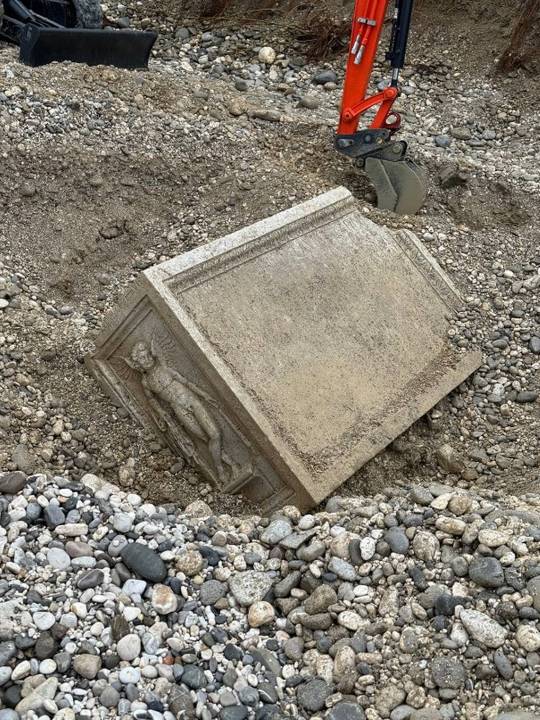
Roman Funerary Altar Found in Italy
Buried in a rocky riverbed in northern Italy sat a forgotten ancient artifact. The artifact certainly wasn’t intended to be forgotten. It was too big and ostentatious for that. But the waterway and the passing centuries had prevailed over the ancient stone.
Not anymore.
Ervino Silvestri spotted the ancient artifact in the gravel of the Torre river in San Vito al Torre and alerted officials, the Superintendency of Archaeology, Fine Arts and Landscape of Friuli Venezia Giulia said in a Feb. 22 news release.
Archaeologists excavated the riverbank and unearthed a massive block of carved limestone. They identified it as an ancient Roman funeral monument.
The monument weighed about 13,000 pounds, archaeologists said. One corner of the rectangular monument was chipped, but the rest was generally intact.
One end had a carved figure of Erotes holding a torch and poppy flower, symbols of eternal sleep or death, officials said. A photo shows the figure inside a carved frame.
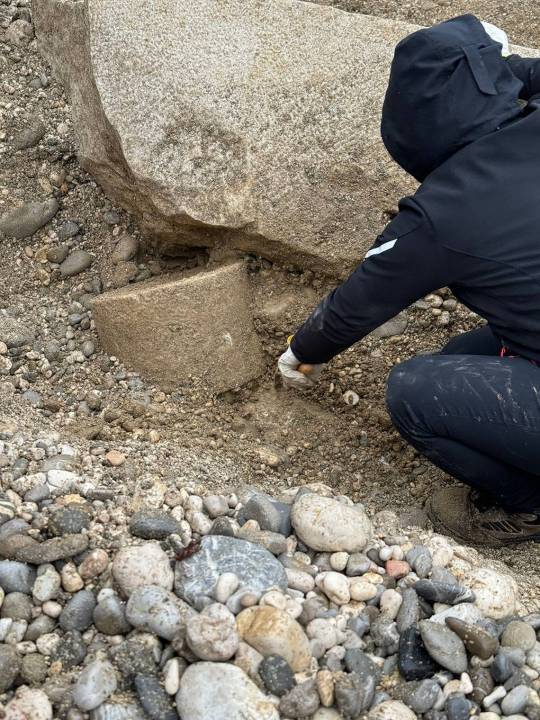

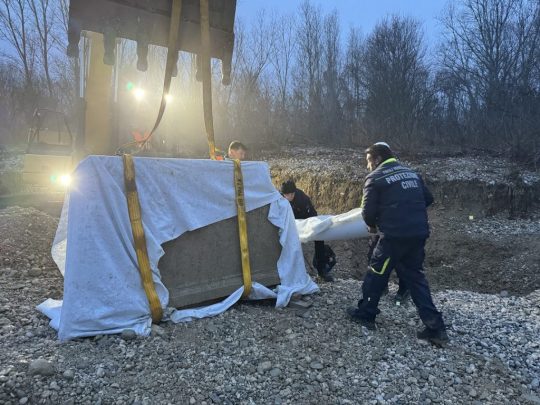
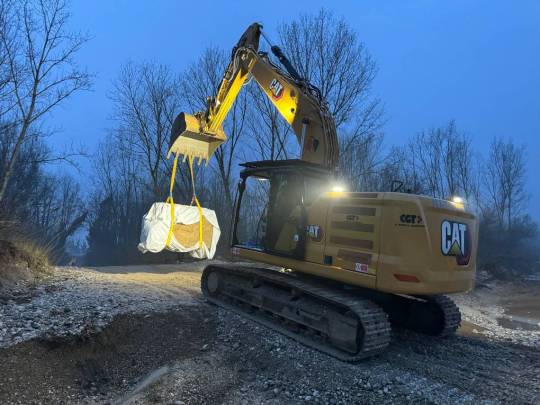
Erotes was a figure of ancient Roman mythology comparable to Cupid or Eros, according to Britannica. Although generally the god of love, Eros could represent different symbols in different contexts.
Archaeologists also found an inscription on the ancient Roman monument but did not provide a translation.
The decoration style indicated the monument was from the high imperial era. Archaeologists did not give a specific date range, but, according to National Geographic, ancient Rome’s imperial era lasted from 27 B.C. to 476 A.D., peaking in 117 A.D.
The stone monument was so heavy that an excavator was needed to move it, officials said. Photos show this process. The artifact was placed in a temporary shelter for cleaning and further study.
Excavations of the gravel riverbed also uncovered a stone urn, a limestone carving of a man’s face, other limestone artifacts, bricks and tile pieces, archaeologists said. Photos shared by officials in a Feb. 22 Facebook post show some of these finds.
San Vito al Torre is about 300 miles northwest of Rome and near the Italy-Slovenia border.
By Aspen Pflughoeft.
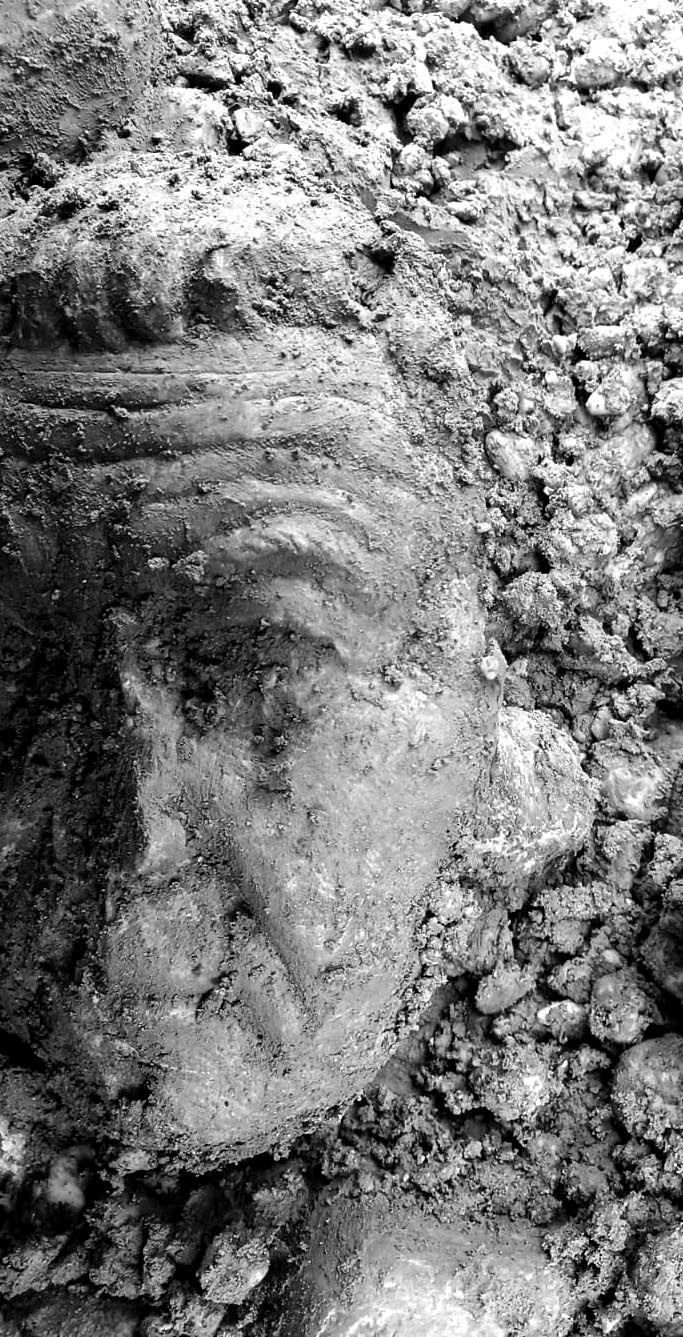
#Roman Funerary Altar Found in Italy#Torre river in San Vito al Torre#carved limestone#Roman funeral monument#ancient artifacts#archeology#archeolgst#history#history news#ancient history#ancient culture#ancient civilizations#roman history#roman empire#roman art
68 notes
·
View notes
Photo

A Gallery of Children of the Ancient World
Children in the ancient world are, generally speaking, underrepresented in art, literature, and archaeological evidence when compared with the larger population owing to their status as wards of adults who are often, though not always, the focus of works depicting them with their children. Children are often only depicted alone on funerary monuments.
Even on tombstones, however, the child is frequently depicted as a secondary character among the mourning adults. The concept of "childhood" as understood in the present is fairly recent and, in the ancient world, was not unknown but certainly not defined as it widely is today. Children were understood as continuations of a family line who would one day, if they lived to maturity, assume the roles of their parents, but they were not recognized as individuals whose lives were interesting enough to warrant a work of art or, unless a eulogy, a poem.
Lower-class children were rarely educated and, by age seven (if not younger), were expected to help with housework or their fathers' profession. Upper-class children in ancient Rome began primary school at age 7, and those girls who were allowed to attend left at the age of 13 to learn domestic responsibilities while boys continued on only if their fathers' professions involved literacy. In ancient Egypt and Mesopotamia, boys (and some girls) continued their education until they graduated as scribes and could then work as physicians, clergy, government bureaucrats, or other professions requiring a knowledge of the written word.
Even so, children in the ancient world, as now, played with dolls, toy soldiers, wooden swords, pull-toys, balls, and other playthings. Children also participated in sports and played board games. The following gallery presents a sampling of artifacts and artworks related to these children of the ancient past.
Continue reading...
41 notes
·
View notes
Text




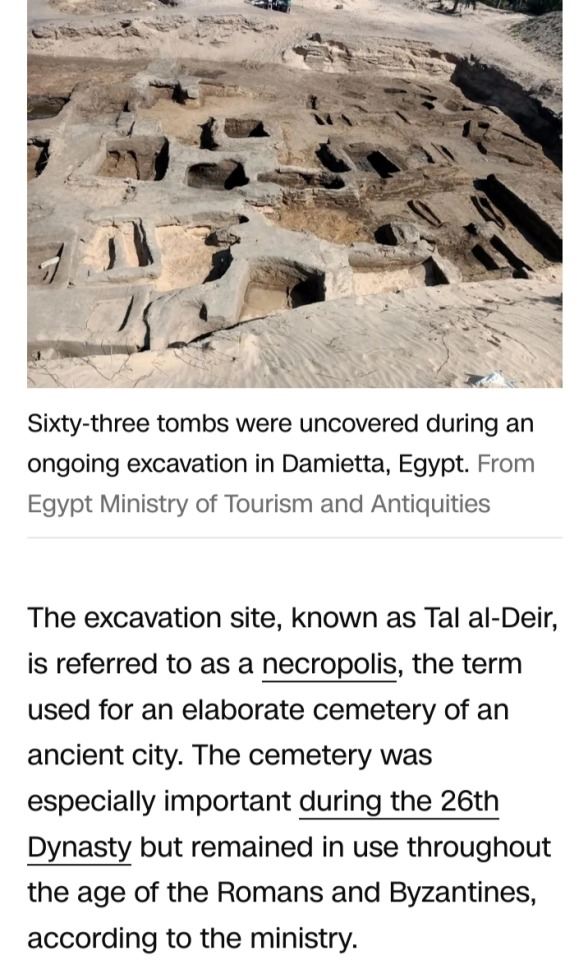

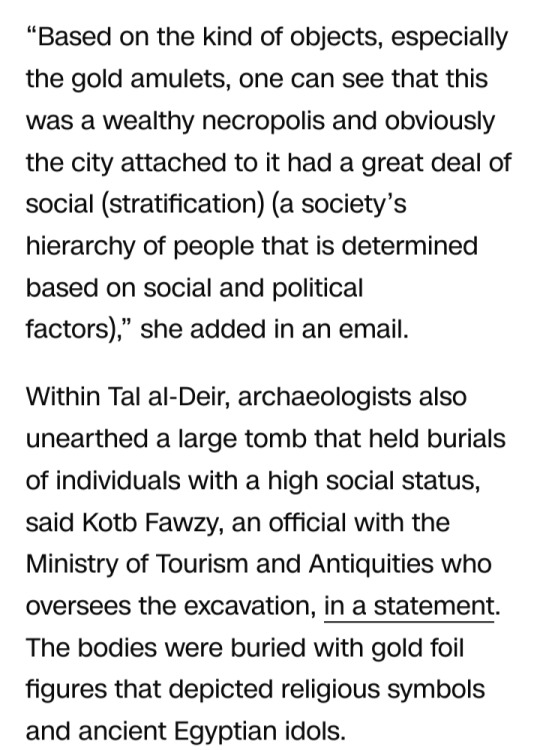


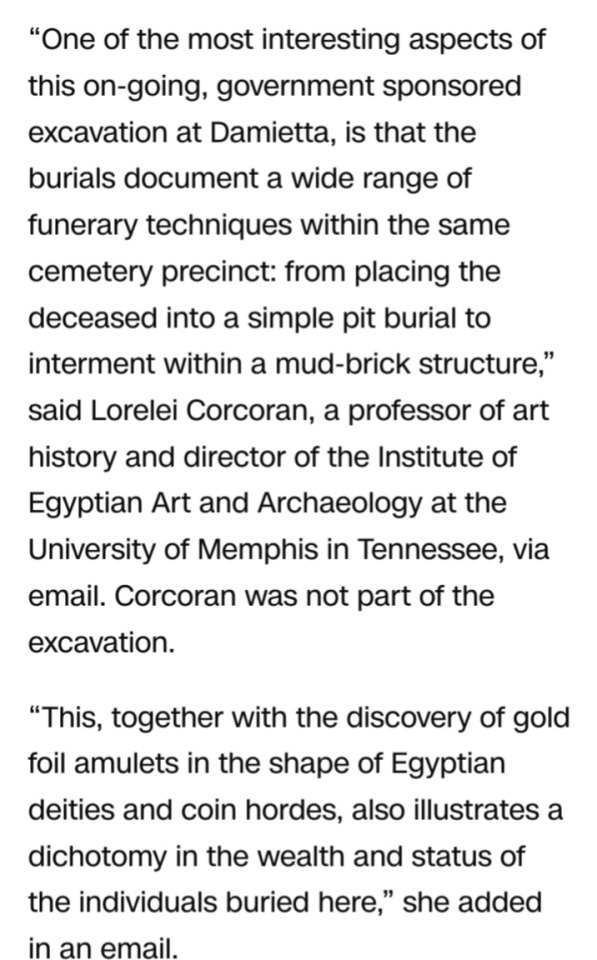
#Ancient Egypt#Egyptian necropolis#Damietta#Egypt#ancient tomb#gold artifacts#excavation#Ancient Egyptian Civilization#ancient civilizations#Ministry of Tourism and Antiquities#funerary amulet#ushabti statues#ptolemaic egypt#Tal al-Deir#necropolis#egyptian history#ancient burial#egyptian deities#archaeology
0 notes
Text

Funerary stele of an infant, Sextus Rufius Achilleus, who died at aged 7 months and 9 days old.
Ancient Roman, 2nd century CE
Terme di Diocleziano, Rome, Italy
Feb. 2024
#tombstone#stele#funerary monument#funerary art#tomb#original photography#photography#taphophile#taphophilia#lensblr#photographers on tumblr#tombs#travel#wandering#artifact#museum#art history#italy#italia#rome#roma#archaeology#ancient art#ancient rome#ancient roman#cemetery#wanderingjana
3 notes
·
View notes